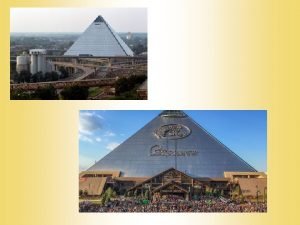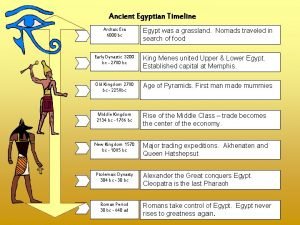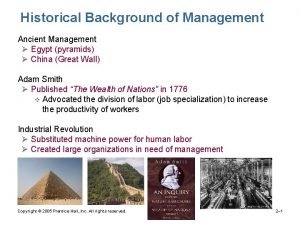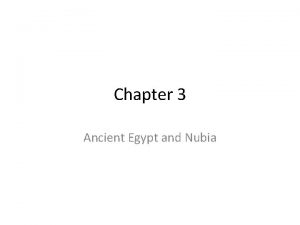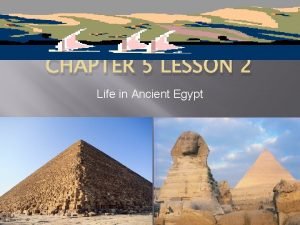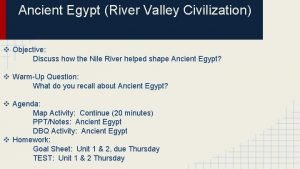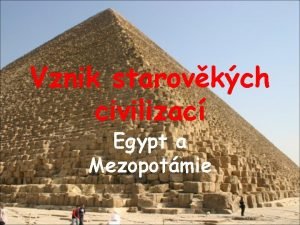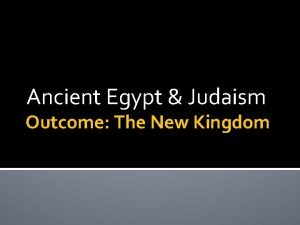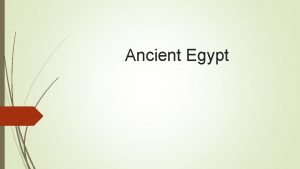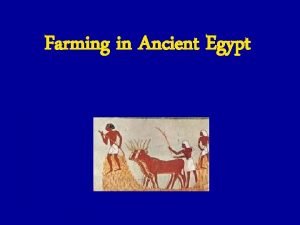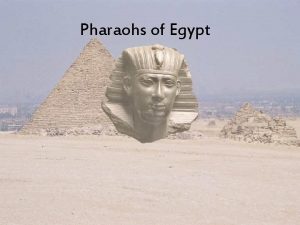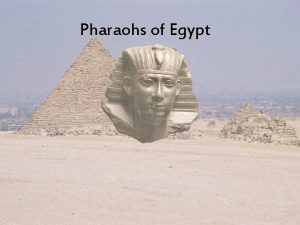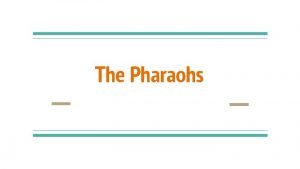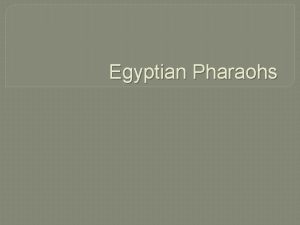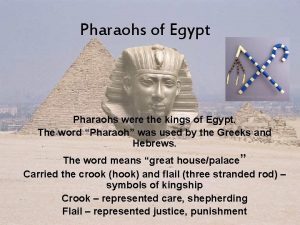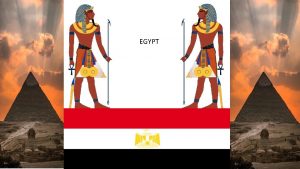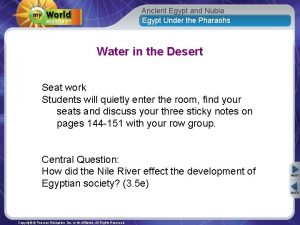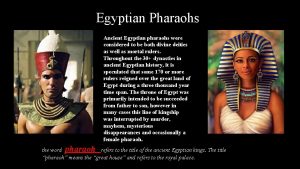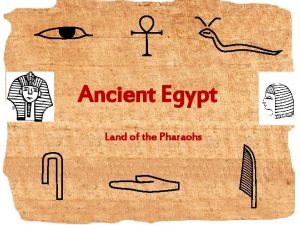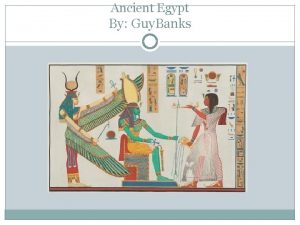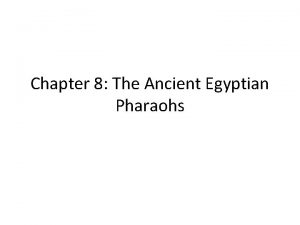Land of the Pharaohs Rulers of Ancient Egypt

















- Slides: 17

Land of the Pharaohs Rulers of Ancient Egypt

Pharaohs were the kings of Egypt Pharaoh was believed by the Egyptians to be the supreme ruler chosen by the gods to lead his people They believed that when a man became a pharaoh, he also became a god According to Egyptian legend, the first kings of Egypt were later some of the most famous gods

Pharaohs The word “Pharaoh” was used by the Greeks and Hebrews The title “Pharaoh” originated from the Greek language and it is used in the Old Testament The title originates in the term "pr-aa" which means "great house" and describes the royal palace

Responsibility of Pharaohs ruled with absolute power Despite absolute power the Pharaoh’s rule was subject to Ma’at and was expected to govern according its principles Ma’at was the goddess and symbol of the equilibrium of the universe Any King that attempted to radically change society would be seen as destroying the equilibrium that was so important to Egyptian tradition resulting in civil war or a challenge in his authority

Succession To keep the pure line of succession, a Pharaoh passed on the throne to the eldest son born of the Principal Queen, or Great Royal Wife Each king was usually keen to demonstrate to his subjects that he was the “chosen” heir The Pharaoh owned all of the land, people, and possessions in Egypt Any personal wealth enjoyed by Egyptians people was considered a result of the generosity of the King.

Key Pharaohs There were several Pharaohs of Egypt. However, we will focus on the main male Pharaohs: • • • Menes Khufu Hatshepsut Thutmose III Akhenaton (Amenhotep IV) Tutankhamen Ramses II Cleopatra Nefertiti Amenhotep III

Menes (c. 3100 – 3050 B. C. E. ) First Pharaoh to unify upper and lower Egypt into one Kingdom and wear the red crown of lower Egypt and the white crown of upper Egypt

Menes (Ruled 3100 – 2850 B. C. E. ) Ancient Egypt’s form of a civilization began with King Menes Founded the city of Memphis because of its good location and easy to defend against attacks During his reign he expanded his kingdom and developed commercial trade links

Khufu (2589 -2566 B. C. E) Ruthless ruler who enslaved people and sold daughter into prostitution Most remembered for building Great Pyramid of Giza The pyramid originally stood 481 feet tall and even today it’s still a mystery to how it was built

Hatshepsut (c. 1470 B. C. E) Remembered as history’s first great woman ruler Hatshepsut became regent when her husband Tuthmosis II died and the new pharaoh was very young (son of a minor wife) Several years later she declared herself “king” and began wearing the false beard and garments of a pharaoh Egypt prospered while she was in power as she established famous trade and economic expedition to the land of Punt Prolific builder and commissioned many architectural projects and the restoration of older temples

Thuthmosis III (c. 1450 B. C. E. ) When his father died his stepmother Hatshepsut, took charge and he was pushed into the background as she ruled Egypt over a 20 year period When Hatshepsut died he came to the throne and as an act of revenge or retribution, he destroyed as many of Hatshepsut's statues, monuments, and buildings He is remembered as “the Napoleon of Egypt; ” a great warrior king who expanded the empire to its greatest size through his successful military campaigns Wealth of the New kingdom came from tributes paid by people he conquered

Akhenaton (c. 1350 B. C. E. ) Original name was Amonhotep IV but his name to Akhenaton which means “he who serves Aton” This was the first attempt at radically changing the polytheistic Egyptian religion with a monotheistic religion He wanted to change the Egyptian supreme god from Amon-Re to Aton Built a new city called Akhetaton which contained new priests and government More concerned with building his vision of a new society than focusing on war and conquest Religious revolution led to tension and revolt in Egypt

Tutankhamen (c. 1334 B. C. E. ) Known as the Boy King of Egypt, he came to the throne when his father Akhenaton died, he became King around age eight Helped restore Egypt's old beliefs from when his father tried to make Egypt a monotheism society and moved the capital back to Thebes He died suddenly at the young age of 18 by a blow to the back of his head Since his tomb had not yet been made, he was laid in a tomb of a member of the nobility He is famous today because of his tomb being found intact by archaeologist Howard Carter in 1922

Rames II (c. 1290 B. C. E. ) Went to the throne at the age of 20 and reigned for 67 years; the second longest reign for any Egyptian King Considered to be the last great Egyptian King bringing Egypt peace and stability Signed earliest known peace treaty in world history after the Battle of Kadesh with the new Hittite king Ramses is remembered for constructing many architectural marvels including the two huge temples at Abu Simbel Constructed more colossal statues, large statues of human or human like figures, than any other Egyptian King Ruled during the time of Moses and used many Jewish slaves to build his monuments and statues

Cleopatra (c. 30 B. C. E. ) Last independent ruler of Egypt Not of Egyptian lineage; descended from Ptolemy who was a general in Alexander the Great’s army (Greek Ptolemy family ruled Egypt for 300 years) She is best known for her beauty who seduced Caesar and fell in love with Marc Antony Committed suicide with Marc Antony when Octavian forces invaded Egypt After her death, Egypt was ruled as a Roman province.

Nefertiti (c. 1370 -1330 B. C. E. ) Queen of Egypt, who was married to Akhenaten (Amenhotep IV) and is known as the most beautiful woman in history In artwork, her status is evident and indicates that she had almost as much influence as her husband For example, she is depicted nearly twice as often in reliefs as her husband, at least during the first five years of his reign It is believed that Nefertiti was active in the religious and cultural changes initiated by her husband (some even maintain that it was she who initiated the new religion) She also had the position as a priest, and she was a devoted worshipper of the god Aten.

Amenhotep III (c. 1386 -1349/13881351 B. C. E. ) Pharaoh who was the son of Thutmose IV Has the most surviving statues in Egypt today Egypt was at the height of its power when he was Pharaoh Was responsible for building what is known as the Colossus of Memnon
 What did khufu accomplish
What did khufu accomplish Upper egypt and lower egypt
Upper egypt and lower egypt 6000 bce egypt
6000 bce egypt Ancient management egypt pyramid
Ancient management egypt pyramid Map of ancient egypt and nubia
Map of ancient egypt and nubia Lesson 2 life in egypt
Lesson 2 life in egypt Renaissance floral design history
Renaissance floral design history Egyptian social pyramid
Egyptian social pyramid Ancient greece jeopardy
Ancient greece jeopardy Ancient egypt slogans
Ancient egypt slogans How did the nile shape ancient egypt dbq answer key
How did the nile shape ancient egypt dbq answer key Kleopatra hrobka
Kleopatra hrobka Specialized jobs in ancient egypt
Specialized jobs in ancient egypt Ebers papyrus
Ebers papyrus Ecological pyramid of energy
Ecological pyramid of energy Ancient egypt and judaism outcome the new kingdom
Ancient egypt and judaism outcome the new kingdom Nile river valley advanced cities
Nile river valley advanced cities What crops did egypt grow
What crops did egypt grow

